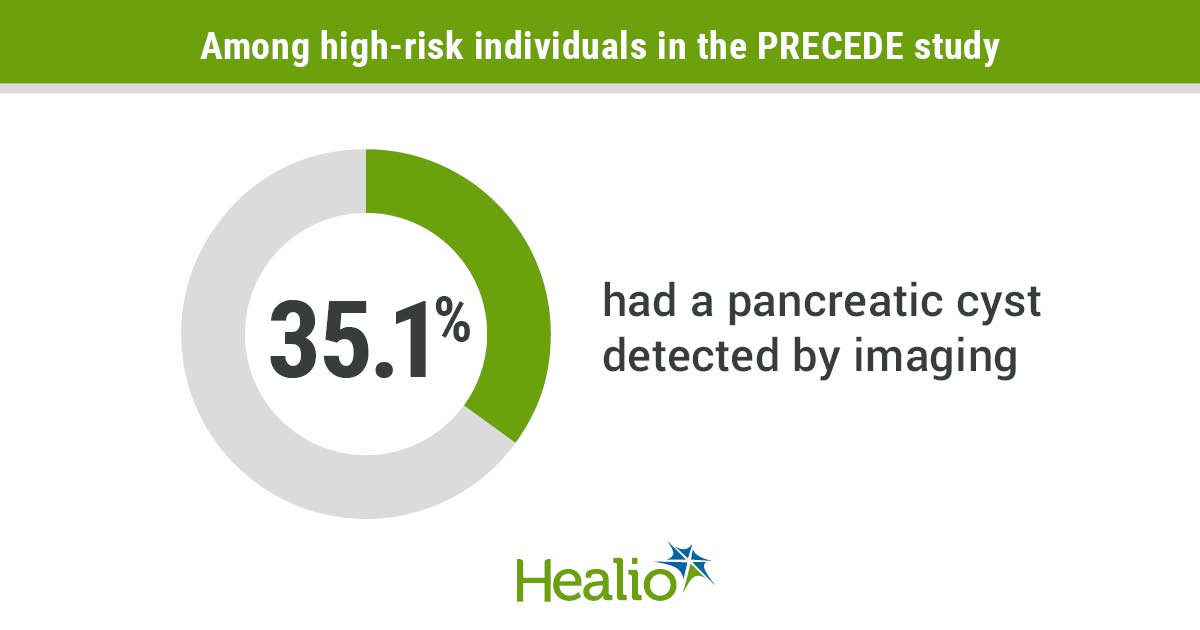April 17, 2024
3 min read

April 17, 2024
3 min read
A consortium recommended classifying people with a high risk for pancreatic cancer into subtypes based on family history and germline variants, according to findings published in Journal of the National Comprehensive Cancer Network.
The Pancreatic Cancer Early Detection (PRECEDE) Consortium found individuals with a family history of pancreatic adenocarcinoma had a significantly higher rate of developing pancreatic cysts compared with those who only had risk based on genetic factors.

“We were not expecting familial pancreas cancer to associate with a higher prevalence of pancreas cysts vs. the other two risk groups detailed,” George Zogopoulos, MD, PhD, associate professor at Rosalind and Morris Goodman Cancer Institute at McGill University in Montreal, told Healio. “This observation supports the notion that the risk for harboring pancreatic abnormalities is not equal among all high-risk groups.”
Pancreatic adenocarcinoma incidence has doubled worldwide since the 1990s, and although OS rates have quadrupled over that same time, it currently stands at just 12%, according to background information provided by researchers.
High mortality rates are due, largely, to roughly 80% of diagnoses being advanced-stage disease. Conversely, more than 80% of patients diagnosed with stage IA pancreatic adenocarcinoma survive at least 5 years.
Surveillance recommendations focus on individuals with a greater than 5% risk for pancreatic adenocarcinoma, but even those who get screened once a year can be missed due the rapid development of the disease.
“Although screening of individuals at average population risk for pancreas cancer is not recommended, there are data to suggest that screening of individuals at high risk is warranted,” Zogopoulos said.
“However, screening of these individuals has not been widely adopted, and many questions remain that will be best addressed through a large collaborative study,” he added. “Important questions that remain include which high-risk individuals will benefit from surveillance and how to best perform surveillance? Can we better tailor surveillance with strategies based on specific germline mutations and family history? PRECEDE offers opportunity for centers to offer screening to high-risk individuals with a research backbone.”
These centers came together to conduct the PRECEDE Longitudinal Cohort Study to answer those questions.
The observational, prospective study enrolled participants aged 18- to 90 years between April 1, 2020, and Nov. 21, 2022, at 25 different sites. Researchers grouped individuals into seven different cohorts based on family history and pathogenic germline variant (PGV).
The total study population consisted of 3,402 patients, including 1,759 in cohort 1, the highest-risk group.
Researchers stratified cohort 1 into three subpopulations — familial pancreatic adenocarcinoma (FPC), PGV-positive/FPC-positive and PGV-positive/FPC-negative.
The FPC group had 839 participants, the PGV-positive/FPC-positive had 138 and PGV-positive/FPC-negative had 782.
Baseline screening occurred in 79.6% of cohort 1.
In total, 35.1% of participants in the group had pancreatic cysts.
Individuals in the FPC cohort had a significantly higher prevalence of pancreatic cysts than the other two groups (FPC, 41.2%; PGV-positive/FPC-positive, 30.4%; PGV-positive/FPC-negative, 29.4%; P < .001).
Of those participants, only two had cysts with a “worrisome feature,” and both came from the FPC group.
“The presence of cysts may identify individuals that are at increased risk [for] developing pancreatic cancer over time because of cyst changes or because the presence of cysts signals that the pancreas has an intrinsic aberration making it more susceptible to cyst progression or other precancerous growths,” Diane M. Simeone, MD, director of Moores Comprehensive Cancer Center at University of California, San Diego, said in a press release. “Longer follow-up time is needed to determine if familial pancreatic cancer signifies a higher risk for developing pancreatic cancer compared to pathogenic germline variant status in a pancreatic cancer predisposition gene.”
Study investigators conducted a logistic regression analysis of the results and found three variables associated with cysts — increasing age (P < .001), diabetes (P = .01) and FPC cohort (P < .001; relative to PGV-positive/FPC-negative).
Study limitations include the cohort size and lack of long-range outcomes and diversity (89% non-Hispanic white).
Researchers project the study to have 10,000 enrollees by 2025, including 5,000 in cohort 1.
“Screening should be offered to individuals at high risk for pancreas cancer, preferably in a research setting,” Zogopoulos said. “All patients with a diagnosis of pancreas cancer should be offered germline testing, as there may be therapeutic actionability — targeted therapy based on a germline mutation — for the proband with pancreas cancer and early detection [or]screening opportunities for their family members.”
George Zogopoulos, MD, PhD, can be reached at [email protected].